Introduction
Jeanet Carrasco was devastated to learn that her son, Ivan Torres, was being bullied at school. Ivan is shy and the bullying did not help his efforts to adjust to elementary school. To make matters worse, Ivan struggled with reading—as demonstrated by his grades. Jeanet tried to schedule a meeting with school staff to create a plan to help Ivan with both issues, but such a meeting never materialized. “The experience was very frustrating. I wanted to get together with the teachers to talk about what Ivan needed, and we never got that,” Jeanet relayed through a translator.
Jeanet learned from her sister about Arizona’s “Empowerment Scholarship Accounts,” otherwise known as education savings accounts. With an account, parents remove their child from a public school and the state deposits a portion of a child’s funds from the state funding formula into a private, parent-controlled bank account. With the savings account, Jeanet enrolled Ivan at St. John the Evangelist in Tucson—making him the first student to use an account there. When Ivan entered St. John’s in fourth grade, he could only read at a second-grade level. After two years, he had caught up to his peers. By seventh grade, he was reading at an eighth-grade level.
Every parent wants to be able to tell a story like this about their child. Education savings accounts are helping to write these stories of achievement and life change for 3,500 children across Arizona. Lawmakers in Florida, Mississippi, Nevada, North Carolina, and Tennessee enacted legislation based on Arizona’s accounts. Some 8,000 students are using accounts in Florida and Mississippi, while another 8,500 students have applied for an account in Nevada and 155 students have applied in Tennessee.[REF] In 2017, North Carolina became the latest state with an account law, while Arizona lawmakers expanded the nation’s oldest accounts (established in 2011), making their state the second to give every child attending public school the choice to use an account—bringing more opportunities to 1.1 million children.[REF]
This Backgrounder explains how education savings accounts help families and students find high-quality learning opportunities. The experience of Arizona families, along with the policies in the five other states with accounts, will help lawmakers in other states as they design similar account options. This Backgrounder can also aid Members of Congress as they consider how the accounts can help students in Washington, DC, military-connected children, and Native American children attending school on tribal lands.
However, teacher unions and other special interest groups have filed lawsuits in three states to block the accounts but have lost on constitutional and procedural grounds in each case. One lawsuit has stalled Nevada’s education savings accounts. This Backgrounder explains the impact on state families and legislative remedies for Nevada lawmakers. Resolving this lawsuit is critical to families across Nevada, as the accounts would be available to every child attending public school in the state.[REF]
Overview of Education Savings Accounts
Parents can use the accounts to buy educational products and services for their child instead of sending him to a traditional or charter public school full-time. Families can hire a personal tutor for their child, find a class online, pay for individual public school classes or extracurricular activities, pay private school tuition, or even save for college. The accounts allow parents to customize their children’s education and choose multiple learning options simultaneously. This feature distinguishes the accounts from K–12 private school vouchers, which are private school scholarships that help families afford tuition and are available to eligible students in states like Ohio and Wisconsin.
With the spread of smartphones and other portable devices allowing children to study virtually anywhere and access educational content from around the world, students can look outside the traditional classroom to find a quality education. Education savings accounts help students do just that.
Students can use their accounts in some states to pay for college classes before or after they graduate high school, helping to prepare them for the ever-changing workforce. Students can use an account to pay for distance learning classes to learn the job skills they need even if such courses are not offered at their school. Every child should have the chance to succeed, no matter where they live or their parents’ income. With an account, families can challenge their child or find the help their child needs to catch up to his peers. Either way, these savings accounts are designed to help students succeed—a goal on which parents, taxpayers, and lawmakers can agree.
The Beneficiaries of Education Savings Accounts
For nearly 30 years, publicly funded private school scholarships have helped families choose a private school for their child when the student is not flourishing at an assigned public school. These vouchers have provided opportunities to families in Wisconsin and Ohio, to name a few. More recently, nonprofit organizations have used charitable contributions to award scholarships to eligible students in Arizona, Florida, and Pennsylvania. More than two dozen states have enacted such laws.
Education savings accounts are a learning solution that helps students harness information and take advantage of a child’s ability to learn on his or her own schedule. Such features are just a few reasons the accounts are beneficial to students, parents, and taxpayers alike.
-
Students. Every child is different and has different learning needs. Parents and students can use an account to customize a child’s education. Students can take classes online for part of the day, work with a personal tutor in the afternoon, and participate in public school extracurricular activities after school. Students can attend private school full time, but, as the research below demonstrates, one-third of account holders in Arizona are using education savings accounts for multiple educational products and services simultaneously. (See the section entitled “Research” below.)
One Arizona student attended a private school full-time with an account, but his parents decided he would be better served meeting with individual tutors and educational therapists—so they left the private school and used the account to pay for services à la carte.[REF]
Students that struggle with certain material can use an account to find additional learning resources or instruction to help them catch up. For students looking to get ahead of their peers, they can use an account to do so. These accounts are as flexible and challenging as students and parents need the accounts to be.
- Parents. The accounts give parents a new way to help their children when their district school is not a good fit for their child. Families that cannot change their neighborhood or have no other public school option for their child have little recourse when their child falls behind in class, is bullied by other students, or simply needs more personally tailored learning options. Education savings accounts give parents the ability to finance multiple learning options for their child. These options can be as straightforward as a new school or can include several learning opportunities each day. With an account, parents need not wait until the next school year for a different class placement or hope that school administrators will intervene. They can decide immediately about where and how a child learns.
-
Taxpayers. Each of the six state education savings account laws have unique provisions, especially concerning that state’s school finance formula. However, without exception, education savings account awards per student are less than the state’s average per student funding. On average, across taxpayers, each child’s account is funded at a lower per student amount than if that child had attended a district public school. (See Chart 1.)
In Arizona, legislative analysts report that each child with special needs using an account saves Arizona taxpayers $1,400.[REF] In the 2016–2017 school year, 58 percent of participating students were children with special needs, resulting in an estimated savings of $3 million for state taxpayers from these students.
Fiscal analysts estimate that the bill Arizona Governor Doug Ducey (R) signed in 2017 giving all state public school students the option to use an account will result in a savings of $11.4 million to taxpayers over four years.[REF]
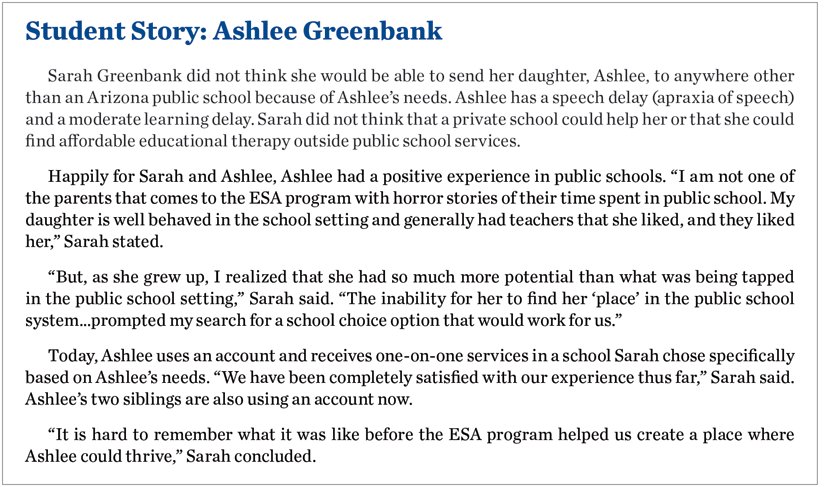
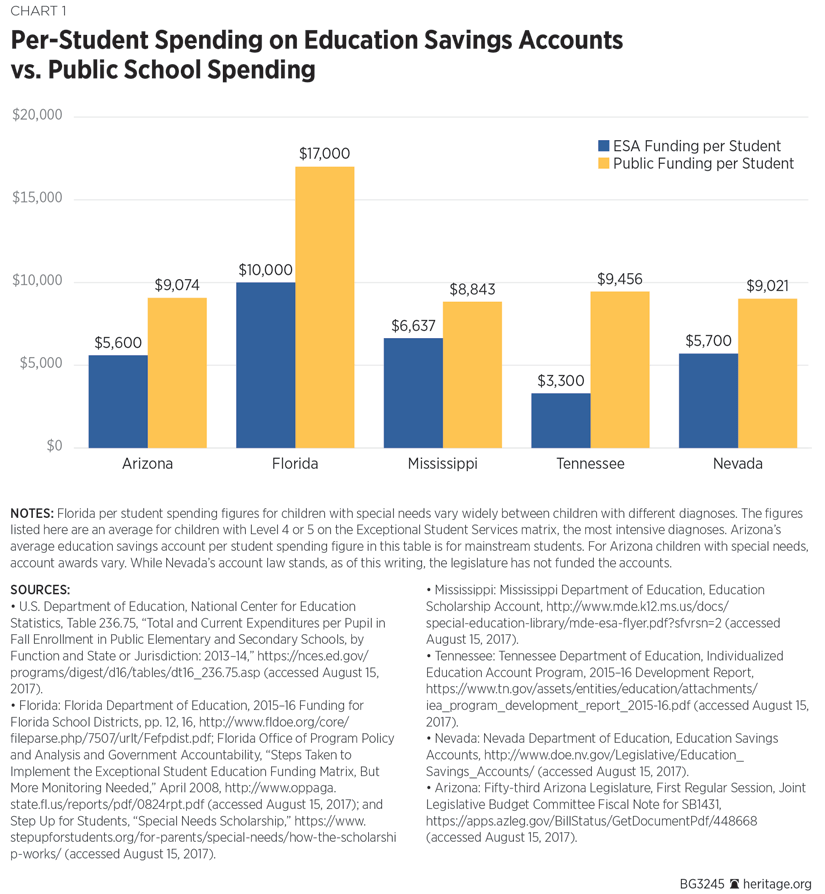
A Step-by-Step Guide to Education Savings Accounts
As of July 2017, lawmakers in six states have enacted education savings accounts as publicly funded personal spending accounts that parents use for student educational expenses instead of enrolling a child in a public school.[REF] Approximately 12,000 students have either registered for an account or are currently participating across the country. (See Chart 2.)
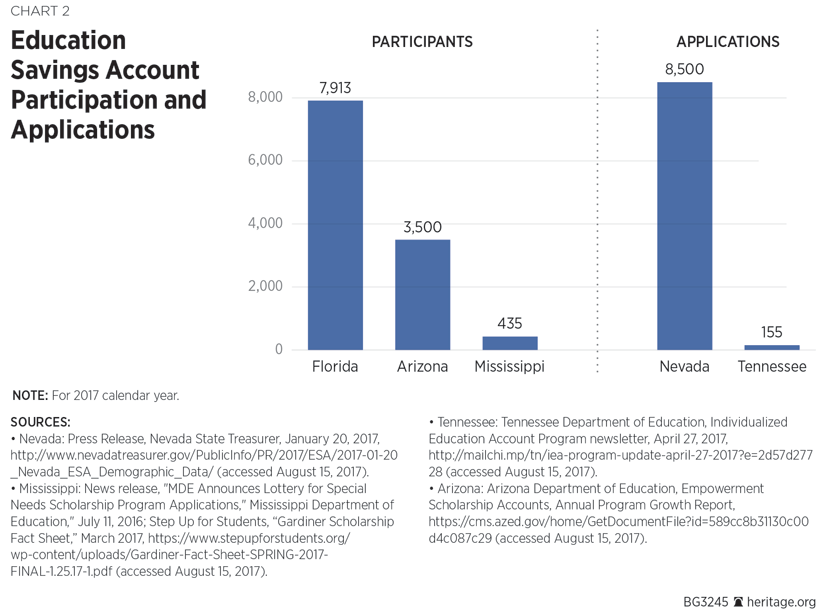
Parents and students access the accounts as follows:
-
Student Eligibility. In Florida, Mississippi, and Tennessee, the accounts are available to children with special needs. The laws in Florida and Tennessee are for children with specific needs, while Mississippi’s accounts are available to all children with an Individualized Education Plan (IEP)—unique education strategies designed by public schools and parents to help children with special needs.
Nevada lawmakers enacted the accounts for all public school students in grades K–12, but a lawsuit stalled implementation. For more information on Nevada’s accounts, see the section entitled “Legal Challenges” below.
From 2011 to 2017, Arizona’s accounts had been available to children with special needs; adopted children; children of active-duty military families; Native American students living on tribal lands in Arizona; children assigned to failing public schools; siblings of existing account holders; and incoming kindergarten students that meet any of these criteria. In addition, students must have attended a public school for 100 days in the prior school year—a provision included in Mississippi, Nevada, North Carolina, and Tennessee’s account laws.[REF]
In 2017, Arizona lawmakers expanded eligibility to include all children attending a public school in kindergarten and first, sixth, and ninth grades.[REF] This bill adds additional grade levels each year until the 2020–2021 school year, when all public school students in grades K–12 have the option to apply for an account.
Also in 2017, North Carolina lawmakers created a new account law for children that meet certain criteria, including students with special needs, children in foster care, and children in active-duty military families.[REF]
-
Applications. State departments of education or, in Florida, K–12 private school scholarship organizations, make account applications available to eligible families.[REF] Families complete the application online or return the appropriate paperwork to the agency.
Application periods for account families differ from state to state. For example, Arizona families can apply at any point during the calendar year; Tennessee applicants have different windows during the year in which to apply to participate in the following school year.
-
Account Awards. In Arizona and Tennessee, a state agency or scholarship organization will send account information, including a debit card and bank account number, to families that complete an application. In Florida and Mississippi, the state agency or scholarship organization that oversees the accounts processes parent and student transactions and do not use a debit card.
In Arizona, the state department of education and treasurer make a quarterly deposit of a child’s funds into the family’s account. When the school year begins in August, the family will have 25 percent of a child’s funds to use immediately. All the account laws lawmakers have enacted so far have a similar process of quarterly disbursements.
-
Account Usage. Parents and students use the accounts for eligible expenses. In Arizona and states that follow its model, parents swipe their prepaid Visa card at vendors’ (such as an educational therapist or private school) card readers, just as they would when buying something from the grocery store.
Each state law lists the allowable uses of the accounts. Some variation exists between states, but the list of lawful learning expenses generally includes:[REF]
- Private school tuition;
- Textbooks;
- Educational therapy;
- Tuition for a vocational program;
- Assistive technology (e.g., braille translation services);
- Personal tutors;
- Curricular materials such as workbooks;
- Online classes;
- Standardized test fees (e.g., for college entrance exams or Advanced Placement tests);
- College tuition;
- College textbooks;
- Public school class fees;
- Extracurricular activity fees;
- School uniforms;
- Transportation costs; and
- Computer hardware.
-
Expense Reports. At the end of each fiscal quarter, parents complete an expense report. Families submit receipts for each purchase to the agency overseeing the accounts. The agency cross-references the items on the report with the bank’s records. Once all transactions have been accounted for, the agency makes the next quarter’s deposit.
If state officials find a discrepancy between a parent’s report and the bank’s register, the agency can withhold the next quarter’s disbursement. State officials can close an account in the event of fraud.[REF] Arizona’s auditor general is the only state agency that has conducted a review of account administration. The auditor reported in 2016 that the state rescinded 1.2 percent of total account awards due to misuse between August 2015 and January 2016.[REF]
Research
Since 2013, researchers have conducted five studies on education savings accounts. Three studies have reviewed parent satisfaction levels among participating families; the other two studies have reviewed how parents and students are using account funds.
Parent Satisfaction. Researchers have found that Arizona and Mississippi families are satisfied with their child’s account.
- A 2013 Goldwater Institute focus group study found 94 percent of respondents reported being “very satisfied” with their child’s account, while the remaining 6 percent were “somewhat satisfied.”[REF] Parents also reported that public school officials had a low level of knowledge about the accounts.[REF] Account holders also reported that they struggled to renew their child’s IEP each year with public school personnel.
- In 2013, EdChoice surveyed participating families’ satisfaction levels.[REF] Seventy-one percent of respondents said they were “very satisfied” with their child’s account experience and 19 percent said they were “satisfied” with their child’s account experience. Even respondents who reported some level of satisfaction with their child’s previous public school also reported some level of satisfaction with an account.
- Researchers in Mississippi surveyed participating families after the first year of education savings account usage.[REF] The study found that 63 percent of participating families reported being “very satisfied” with their child’s account, and 28 percent reported being “somewhat satisfied” with their child’s account.
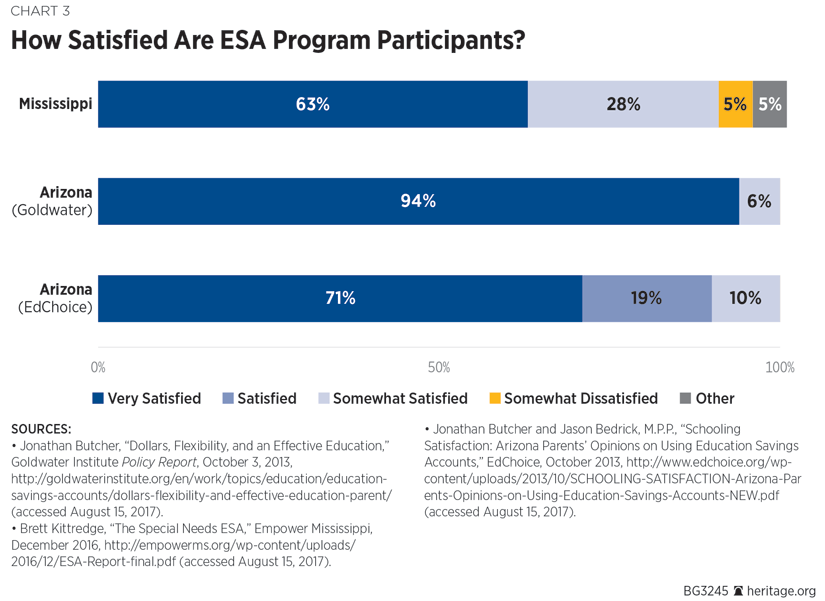
Education Savings Account Usage. Researchers used data from Arizona’s savings accounts to study how families are using their child’s account. The research demonstrates that approximately one-third of account holders are using their child’s account for multiple products and services simultaneously—the feature of the accounts that separates them from K–12 private school scholarships.
- In 2013, The Heritage Foundation’s Lindsey Burke found that 34 percent of account holders used the account for “multiple educational options.”[REF] The data revealed that 207 families paid private school tuition at 87 schools.
- In 2016, researchers used a similar data set containing spending data from 2013–2015 and found that 28 percent of account holders used an account for multiple products and services simultaneously.[REF] During these years, parents spent less as a percentage on private school tuition and more on personal tutors than in the 2013 study.
Litigation
Arizona. In 2011, just months after Arizona Governor Jan Brewer (R) signed Empowerment Scholarship Accounts into law, Arizona’s teacher union and school board association filed a lawsuit to prevent families from using the accounts.[REF] Unions and other interest groups challenged that the accounts violated state constitutional provisions—commonly known as Blaine Amendments—preventing the use of public funds for religious purposes because some students could use the accounts to pay tuition at parochial schools.[REF] Such challenges had upended publicly funded private school scholarships in Arizona and Florida, although the U.S. Supreme Court ruled in 2002 that private school vouchers do not violate the U.S. Constitution.[REF]
Arizona courts ruled in favor of families and their children, emphasizing the distinction between education savings accounts and private school vouchers. In the unanimous appeals court decision, Judge Jon W. Thompson wrote,
The ESA does not result in an appropriation of public money to encourage the preference of one religion over another, or religion per se over no religion. Any aid to religious schools would be a result of the genuine and independent private choices of the parents.[REF]
In 2014, the Arizona Supreme Court did not take the case and let this ruling stand.
Florida. Unions were also responsible for a legal challenge to the accounts (now called Gardiner Scholarships) in Florida. In 2014, the Florida Education Association filed a lawsuit based on procedural grounds to block the state’s new account law.[REF] The union argued that the bill that enacted the accounts violated the state constitution’s “single subject” rule, which requires pieces of legislation to deal with only one policy at a time.
The Goldwater Institute defended families using Florida’s accounts—now called Gardiner Scholarships. A Leon County judge dismissed the suit in December 2014.[REF]
Nevada. The American Civil Liberties Union of Nevada filed a lawsuit against the state’s accounts in 2015, before the state treasurer was even able to begin awarding accounts to applicants. The ACLU filed a challenge similar to that of Arizona’s teacher union and other special interest groups lodged against the accounts in 2011. The Nevada ACLU claimed that the accounts violate Nevada’s Blaine Amendment. The state supreme court rejected this argument, with Justice James W. Hardesty writing,
Once the public funds are deposited into an education savings account, the funds are no longer “public funds” but are instead the private funds of the individual parent who established the account. The parent decides where to spend that money for the child’s education and may choose from a variety of participating entities, including religious and non-religious schools. Any decision by the parent to use the funds in his or her account to pay tuition at a religious school does not involve the use of “public funds.”[REF]
Unfortunately for Nevada families, Educate Nevada Now also filed a lawsuit against the program. The group charged that the state cannot fund education savings accounts with funds that would otherwise be used for these children at traditional public schools.[REF] In the same ruling that found the accounts did not violate the state’s Blaine Amendment, the court ruled in favor of Educate Nevada Now. As a result, lawmakers must find a new funding source for the accounts so that the state can begin awarding accounts. As of the end of the 2017 legislative session (including the special session after the conclusion of the regular session), lawmakers had not secured a vehicle to fund the accounts.[REF]
Policy Recommendations
State and federal lawmakers who want to make the accounts available to families in their state or Washington, DC, should consider the following key provisions in an account law.
Eligibility. Just as every child can attend a local public school, so should every child be eligible for an account. The accounts should be a viable way for students to satisfy the state’s truancy requirement just like attending a traditional school, charter school, private school, or homeschool.
Lawmakers in more than two dozen states have enacted K–12 private school choice laws, and almost every state allows teachers and community leaders to form public charter schools—public schools of choice. Yet none of these opportunities has caused students to leave traditional schools in such large numbers that district schools have had to close as a result. In fact, total enrollment in public schools nationwide has increased 22 percent since 1990, when Wisconsin lawmakers enacted the nation’s first K–12 private school voucher law.[REF]
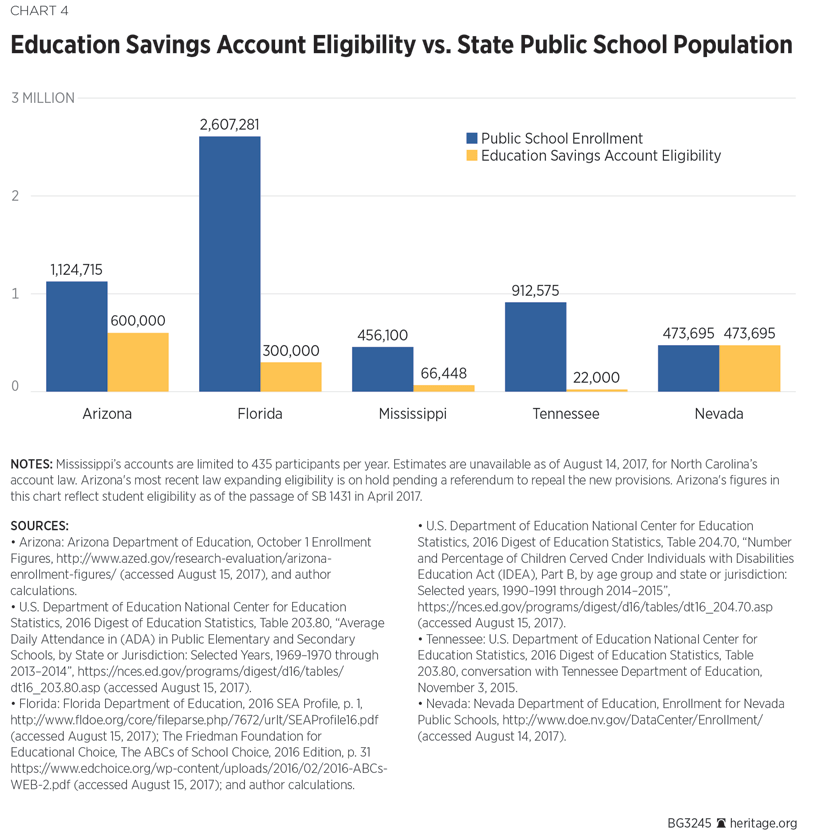
Allowable Expenses. Lawmakers should create a broad list of eligible expenses for participating families. As described above, learning options such as private school tuition, online classes, personal tutors, and college expenses should be allowable uses for account holders because these opportunities help students to find challenging resources inside and outside the classroom.
Lawmakers should also consider allowing families to purchase computer hardware, as assistive technologies are valuable for children with special needs. Families should be allowed to pay for educational summer camps and school uniforms, as such additional fees are common in a child’s educational career.
Lawmakers should make the list of allowable uses accessible to parents in order to help prevent unintentional misuse of the accounts and give families clear directions for how to use their child’s account. Because every child is unique, lawmakers should include the widest range of possible account uses—different students benefit from different instructional practices. Many educational practices lead to student achievement among different student groups, but no research exists that finds one instructional technique works for all students, all the time, in every conceivable setting. Lawmakers should give parents the ability to choose from a large offering of educational services in order to find the best learning experience for their student. Policymakers can include such a list in a parent handbook and on the state’s department of education website.
Achievement. Standardized tests are a limited measure of a child’s achievement. Therefore, lawmakers should not require account holders to complete a single uniform state test each year in order to remain eligible for an account. Evidence from a private school choice option in Louisiana that has broad student eligibility rules but strict provisions for private school participation demonstrates that such testing requirements can limit private school and provider participation, which limits the options available to families.[REF]
State policymakers should equip parents to be responsible for their child’s academic accountability. For example, lawmakers could require families to choose a nationally referenced standardized test, college entrance exam, or Advanced Placement test in math and reading each year. For students attending a private school, account holders should be allowed to satisfy this requirement by taking the annual assessment of the school’s choice or by choosing a different test outside school.
Test results should not be used to determine a child or school’s continued eligibility in an account system. However, the tests can help parents and teachers measure a child’s reading ability, especially important for students in grades two through five. In these grades, students transition from learning to read to reading to learn.
Fraud Prevention. To prevent misuse of the accounts, lawmakers should create a 1-800 number for individuals and businesses to report suspected fraud, along with an online fraud-reporting form. State auditors or inspectors general should conduct annual reports on how parents and students are using the accounts, including incidents of misspending.
In Florida, parents gain approval for a lawful educational expense before spending their own funds on their account holder. The state then reimburses families out of the child’s account funds for each purchase. In some cases, Florida policymakers have facilitated direct payments to educational vendors.
In Arizona, policymakers restrict the debit cards so that they can only be used at certain vendors, which has limited many kinds of misuse but requires that misspending be resolved after a purchase is made. These provisions, coupled with quarterly disbursements after parents have completed expense reports, have protected taxpayers and participating students from the widespread fraud that plagues district schools.[REF] Arizona policymakers are currently revising their accounts to include the best features of Florida and Nevada’s systems and the flexibility of mobile payment technology.[REF]
Homeschooling. Arizona pioneered a provision that protects homeschool families that do not want to use an education savings account from being impacted by changes to laws governing the accounts. At the same time, the provisions also allow students to use an account and be educated at home.
In 2012, Arizona lawmakers enacted H.B. 2622, which expanded access to the accounts to include children attending failing public schools.[REF] The bill also specified that the accounts are a separate way to satisfy the state’s truancy provision, alongside attending a traditional public or charter school, private school, or homeschool. This prevents any future changes to account students, such as testing requirements, from being applied to families homeschooling without an account.
Policymakers should allow families to use an account to educate their child at home, using an account to purchase textbooks, curricular materials, and other learning resources. State or federal laws should treat families homeschooling without an account separately from education savings account students who school at home or craft an à la carte educational experience.
Conclusion
For Ivan Torres, the experience of overcoming the odds with the help of an account and the team at St. John the Evangelist in Tucson is not the end of his family’s success story. In 2014, Arizona lawmakers expanded student eligibility for the accounts to include siblings of current account holders, and Ivan’s mom, Jeanet, applied for an account for Ivan’s brother, Zaith. After one year at St. John’s, Zaith’s reading scores doubled. “I’m very proud and excited to see how my children are being appreciated and treated at St. John’s and awarded for their academic standing,” Jeanet says. “And I feel that this is a very safe place for them to be.”
Some families are satisfied with a student’s assigned school, and anyone who does not wish to use an account is not required to do so. However, education savings accounts can help parents access an educational environment as unique as their child. Every child should have the opportunity to access and enjoy such an environment and the rewarding experiences it brings.
—Jonathan Butcher is Senior Policy Analyst in the Center for Education Policy, of the Institute for Family, Community, and Opportunity, at The Heritage Foundation.
Appendix A: Arizona’s Education Savings Account (Empowerment Scholarship Account) Law
Arizona’s education savings accounts are the oldest such accounts in the U.S. The table below provides more information about the accounts, which began as an option for children with special needs but were expanded to be an opportunity for every Arizona child attending public school. The law described below also explains how the accounts’ implementation changed over time. Other state lawmakers modeled many of the provisions of their account laws after Arizona’s.
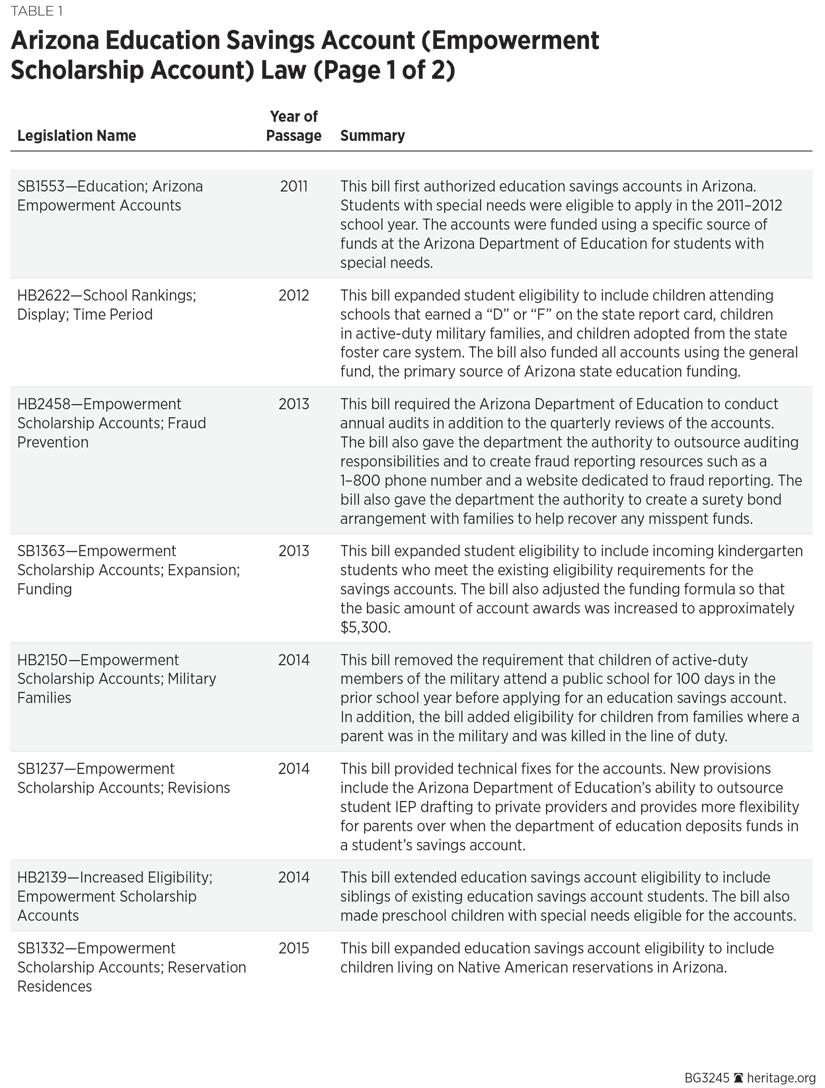
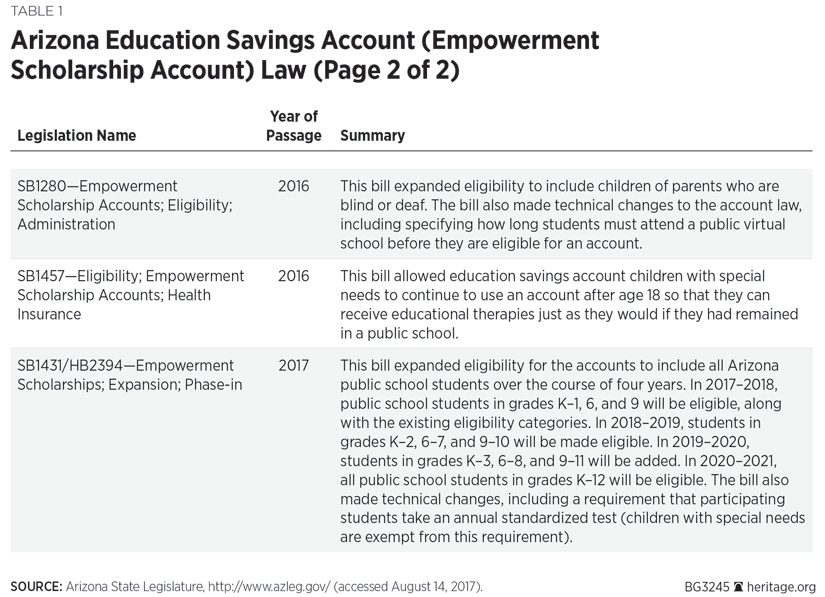
Appendix B: Education Savings Accounts in the States
Arizona
- Enacted: 2011.
- Eligibility: Children with special needs; students assigned to failing public schools; children in active-duty military families; adopted children; incoming kindergarten students that meet other eligibility criteria; siblings of existing account holders; preschool children with special needs; children living on Native American reservations; and a child of a parent who is legally blind or deaf. In 2017–2018, public school students in grades K–1, 6, and 9; in 2018–2019, students in K–2, 6–7, and 9–10; in 2019–2020, grades K–3 and 6–11; in 2020–2021, grades K–12.[REF]
- Cap: From 2014 to 2022, account participation can grow no larger than a figure equivalent to 0.5 percent of the total Arizona public school population. Under current law, no new students can apply for an account after 2022.
- Prior year public school attendance requirement: Yes.
- Average account award per student: $4,500 for mainstream students; $5,000 for low-income students; $13,000–$15,000 for children with special needs.
- Account access: Prepaid debit card.
Florida
- Enacted: 2014.
- Eligibility: Students with specific special needs including blind and deaf students, along with children with the following diagnoses: anaphylaxis; autism; cerebral palsy; Down syndrome; dual sensory impairment; hospitalization or homebound designations; intellectual disabilities concurrent with “deficits in adaptive behavior” that are “expected to continue indefinitely” in a child’s life; Prader–Will syndrome; rare disorders that affect fewer than 200,000 U.S. individuals; spinal bifida; traumatic brain injury; and Williams syndrome.[REF]
- Cap: None.
- Prior year public school attendance requirement: No.
- Average account award per student: $10,000.
- Account access: Parent reimbursement, direct payment to vendors.
Mississippi
- Enacted: 2015.
- Eligibility: Children with special needs with an Individualized Education Plan.
- Cap: 435.
- Prior year public school attendance requirement: Yes.
- Average account award per student: $6,500.
- Account access: Parent reimbursement.
Tennessee
- Enacted: 2015.
- Eligibility: Children diagnosed with autism; deaf-blindness; developmental delay; hearing impairments; intellectual disability; multiple disabilities; orthopedic impairments; traumatic brain injury; or visual impairments.
- Cap: None.
- Prior year public school attendance requirement: Yes.
- Average account award per student: $3,300.
- Account access: Debit card.
Nevada[REF]
- Enacted: 2015.
- Eligibility: All public school students.
- Cap: None.
- Prior year public school attendance requirement: Yes.
- Average account award per student: $5,700 for low-income students; $5,100 for all others.
- Account access: Direct payment to vendors.
North Carolina
- Enacted: 2017.
- Eligibility: Children diagnosed with one or more of the following: autism; hearing impairment; intellectual disability; orthopedic impairment; other health impairments; serious emotional disturbance; specific learning disabilities; speech or language impairment; traumatic brain injury; visual impairment; students in foster care; students entering kindergarten or first grade; and children of active-duty U.S. military members.
- Cap: Lawmakers appropriated $3 million for account awards in 2018–2019. At $9,000 per account, 330 students should be able to use the accounts.
- Average account award per student: $9,000.
- Account access: TBA.




